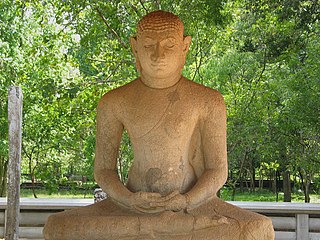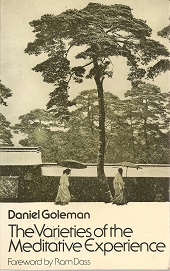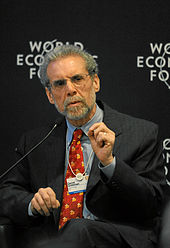
Meditation is a practice in which an individual uses a technique – such as mindfulness, or focusing the mind on a particular object, thought, or activity – to train attention and awareness, and achieve a mentally clear and emotionally calm and stable state.

Yoga is a group of physical, mental, and spiritual practices or disciplines which originated in ancient India and aim to control (yoke) and still the mind, recognizing a detached witness-consciousness untouched by the mind (Chitta) and mundane suffering (Duḥkha). There is a wide variety of schools of yoga, practices, and goals in Hinduism, Buddhism, and Jainism, and traditional and modern yoga is practiced worldwide.

Samādhi, in Buddhism, Hinduism, Jainism, Sikhism and yogic schools, is a state of meditative consciousness. In Buddhism, it is the last of the eight elements of the Noble Eightfold Path. In the Ashtanga Yoga tradition, it is the eighth and final limb identified in the Yoga Sutras of Patanjali.

Daniel Goleman is an author, psychologist, and science journalist. For twelve years, he wrote for The New York Times, reporting on the brain and behavioral sciences. His 1995 book Emotional Intelligence was on The New York Times Best Seller list for a year and a half, a bestseller in many countries, and is in print worldwide in 40 languages. Apart from his books on emotional intelligence, Goleman has written books on topics including self-deception, creativity, transparency, meditation, social and emotional learning, ecoliteracy and the ecological crisis, and the Dalai Lama’s vision for the future.
Yogachara is an influential tradition of Buddhist philosophy and psychology emphasizing the study of cognition, perception, and consciousness through the interior lens of meditative and yogic practices. Yogachara was one of the two most influential traditions of Mahayana Buddhism in India, the other being Madhyamaka.
The relationship between Buddhism and science is a subject of contemporary discussion and debate among Buddhists, scientists and scholars of Buddhism. Historically, Buddhism encompasses many types of beliefs, traditions and practices, so it is difficult to assert any single "Buddhism" in relation to science. Similarly, the issue of what "science" refers to remains a subject of debate, and there is no single view on this issue. Those who compare science with Buddhism may use "science" to refer to "a method of sober and rational investigation" or may refer to specific scientific theories, methods or technologies.

Buddhist meditation is the practice of meditation in Buddhism. The closest words for meditation in the classical languages of Buddhism are bhāvanā and jhāna/dhyāna.
Rūpa means "form". As it relates to any kind of basic object, it has more specific meanings in the context of Indic religions.
The elephant goad, bullhook, or ankus is a tool employed by mahout in the handling and training of elephants. It consists of a hook which is attached to a 60–90 cm (2.0–3.0 ft) handle, ending in a tapered end.
Sati, literally "memory" or "retention", commonly translated as mindfulness, "to remember to observe," is an essential part of Buddhist practice. It has the related meanings of calling to mind the wholesome dhammas such as the four establishments of mindfulness, the five faculties, the five powers, the seven awakening-factors, the Noble Eightfold Path, and the attainment of insight, and the actual practice of maintaining a lucid awareness of the dhammas of bodily and mental phenomena, in order to counter the arising of unwholesome states, and to develop wholesome states. It is the first factor of the Seven Factors of Enlightenment. "Correct" or "right" mindfulness is the seventh element of the Noble Eightfold Path.

Krishnamurti's Journal is a diary of 20th-century Indian philosopher Jiddu Krishnamurti (1895–1986). The handwritten journal eschews the first person, and is composed of entries dated in 1973 and 1975. The entries touch on favorite Krishnamurti topics like meditation, the dangerous effects of identification and of conditioned thinking, and the need for radical individual psychological reset. The diary is also known for poetic and nuanced descriptions of nature, and of nature's relationship with human consciousness. It was originally published in book form in 1982.

Dhyāna in Hinduism means contemplation and meditation. Dhyana is taken up in Yoga practices, and is a means to samadhi and self-knowledge.

Buddhism includes an analysis of human psychology, emotion, cognition, behavior and motivation along with therapeutic practices. Buddhist psychology is embedded within the greater Buddhist ethical and philosophical system, and its psychological terminology is colored by ethical overtones. Buddhist psychology has two therapeutic goals: the healthy and virtuous life of a householder and the ultimate goal of nirvana, the total cessation of dissatisfaction and suffering (dukkha).

Bruce Alan Wallace is an American author and expert on Tibetan Buddhism. His books discuss Eastern and Western scientific, philosophical, and contemplative modes of inquiry, often focusing on the relationships between science and Buddhism. He is founder of the Santa Barbara Institute for Consciousness Studies.

In the oldest texts of Buddhism, dhyāna or jhāna is a component of the training of the mind (bhavana), commonly translated as meditation, to withdraw the mind from the automatic responses to sense-impressions, "burn up" the defilements, and leading to a "state of perfect equanimity and awareness (upekkhā-sati-parisuddhi)." Dhyāna may have been the core practice of pre-sectarian Buddhism, in combination with several related practices which together lead to perfected mindfulness and detachment.

Zen and the Art of Consciousness (2011), originally titled Ten Zen Questions (2009), is a book by Susan Blackmore. It describes her thoughts during zazen retreats and other self-directed meditative exercises, and how those thoughts relate to the neuroscience of consciousness. Most chapters in the book center around a Zen question and describe Blackmore's inner monologue contemplating the question's implications for subjective experience. The final chapter features a response by Blackmore's Zen teacher.

Waking Up: A Guide to Spirituality Without Religion is a 2014 book by Sam Harris that discusses a wide range of topics including secular spirituality, the illusion of the self, psychedelics, and meditation. He attempts to show that a certain form of spirituality is integral to understanding the nature of the mind. In late September 2014, the book reached #5 on The New York Times Non-Fiction Best Sellers list.

Why Buddhism is True: The Science and Philosophy of Meditation and Enlightenment is a 2017 book by Robert Wright. As of August 2017, the book had peaked at The New York Times No. 4 bestseller in hardcover nonfiction.

Altered Traits: Science Reveals How Meditation Changes Your Mind, Brain, and Body, published in Great Britain as 'The Science of Meditation: How to Change Your Brain, Mind and Body', is a 2017 book by science journalist Daniel Goleman and neuroscientist Richard Davidson. The book discusses research on meditation. For the book, the authors conducted a literature review of over 6,000 scientific studies on meditation, and selected the 60 that they believed met the highest methodological standards.

Mindful Yoga or Mindfulness Yoga combines Buddhist-style mindfulness practice with yoga as exercise to provide a means of exercise that is also meditative and useful for reducing stress. Buddhism and Hinduism have since ancient times shared many aspects of philosophy and practice including mindfulness, understanding the suffering caused by an erroneous view of reality, and using concentrated and meditative states to address such suffering.
















